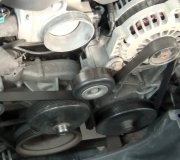I'm not an expert on either of those vehicles. I live in the middle of Wisconsin where we got dumped on with twice as much snow last winter as normal. My daily driver is a rusty trusty '88 Dodge Grand Caravan that has never been stuck where I couldn't get it unstuck without help. Even one winter with almost bald front tires, it went through the snow like a four-wheel-drive truck. I haven't even bothered to plow my really long driveway unless I'm expecting company.
Now, ... I also have a '95 Grand Caravan with the "redesigned suspension system that makes it ride more like car" B.S. If there's a snowflake anywhere in the county, that van is stuck. It just isn't the same vehicle.
Because of my older van, I have a hard time understanding when friends say they need a four-wheel-drive. If you have your mind made up on one of those two models, I'm not aware of any common failures, but in general, the newer the vehicle, the more ridiculously complicated electrical systems they will have. The insane use of computers for systems that never needed computers before is why I'm hanging on to my '88 van. On average, I would estimate it has needed a minor repair about once every four or five years, (other than tires). Most of my friends have one to five-year-old vehicles, and it is common for them to have $500.00 to $800.00 repair bills more than once a year, and they think that's normal and acceptable.
What I WOULD suggest is if you find a vehicle you're thinking about buying, go to the Rock Auto web site and look up the timing belt or related components. If you find the notation, "interference engine" included in the part description, think real hard before committing to that car. My van has over 415,000 miles and is on its first replacement timing belt. If it breaks, I'll coast to the side of the road, get towed home, pop a new belt on, and go driving. With an interference engine, when the timing belt breaks, the open valves get hit and bent by the pistons as they coast to a stop. That turns my $50.00 repair into about a $1500.00 repair. I don't worry about my belt breaking because that valve damage won't occur.
Be aware too that in the '80s and '90s, Honda recommended replacing the timing belt every 75,000 miles, and they typically broke at 65,000 miles. Those were interference engines, and there were a lot of very unhappy owners. I don't know the failure history on their newer vehicles. I DO know that on Chrysler products, the timing belts rarely break up to 25,000 miles beyond the service recommendations. For other brands, I haven't heard any common horror stories about early failures, but to be safe, you'll want to know the replacement interval recommendation, and don't exceed it.
You might consider asking at a dealership if a computer needs to be replaced on the vehicle you're looking at, does it have to be programmed by the dealer to the specific car. That is a clever trick designed by GM to make lots of money from unsuspecting owners. You want a car that you or your mechanic can buy a good used computer from a salvage yard and pop it in with no programming needed.
Sunday, July 6th, 2014 AT 11:23 PM


